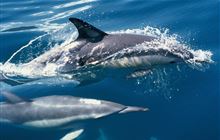Other marine protection tools
Introduction
These marine protection tools are similar to Type 1 and 2 Marine Protected Areas, but don't protect sufficient biodiversity to meet the protection standard.Benthic Protection Areas
In April 2007, in response to a fishing industry proposal, the Government closed 17 areas within New Zealand’s exclusive economic zone (EEZ) to dredging and placed tight restrictions on trawling in those areas.
The intention of the restrictions is to prohibit bottom trawling but to allow for midwater trawling to take place, providing it is closely monitored. The purpose of these restrictions is to protect vulnerable benthic (seafloor) biodiversity, particularly hydrothermal vents. All Benthic Protection Areas are managed by the Ministry for Primary Industries (MPI).
Benthic Protection Areas information on MPI website
Seamount Area Closures
In 2001 the Government prohibited trawling in 17 seamounts distributed throughout the EEZ. Within these areas all trawling is prohibited – there is no provision for midwater trawling. The purpose of these closures is to protect vulnerable benthic (seafloor) biodiversity. All Seamount closures are managed by MPI.
There is some overlap between Benthic Protection Areas and seamount closures with four seamount closures occurring within a Benthic Protection Area. In these cases, the seamount closure provisions apply, with a prohibition on all trawling activity.
Seamount Area Closures on MPI website
Marine mammal sanctuaries
Marine mammals have a special place in New Zealand’s natural and cultural heritage. Māori have a strong traditional relationship with whales, and many of the earliest European immigrants to New Zealand were whalers and sealers. More recently, New Zealand has been at the global forefront of marine mammal conservation and sustainable tourism.
New Zealand is home to a great variety of marine mammals, with around 43 species of cetaceans (whales, dolphins and porpoises) and nine species of pinnipeds (seals). All marine mammals are fully protected in New Zealand waters under the Marine Mammals Protection Act 1978, which DOC administers.
Marine mammal sanctuaries are designed to protect marine mammals from harmful human impacts, particularly in vulnerable areas such as breeding grounds and on migratory routes. This has been done in various ways such as restricting commercial fishing and certain methods of recreational fishing. DOC is responsible for the implementation, management and monitoring of all marine mammal sanctuaries.
Marine mammal sanctuaries:
- Te Pēwhairangi (Bay of Islands)
- Auckland Islands – also a marine reserve
- Banks Peninsula – also includes Akaroa and Pōhatu marine reserves
- Catlins Coast
- Clifford and Cloudy Bay
- Te Waewae Bay
- West Coast North Island - also includes Tapuae and Parininihi marine reserves.
There are also two sanctuaries administered under the Kaikōura (Te Tai o Marokura) Marine Management Act 2014:
With these two Kaikōura sanctuaries, New Zealand has a total of eight sanctuaries that provide special protection for marine mammals.
Customary management
Mataitai reserves
The purpose of mataitai reserves is to provide for customary fishing use and management practices. They are developed and managed by local iwi/hapū with MPI, applying customary management and food gathering practices.
Though not proposed primarily for biodiversity protection, if tangata whenua so wish then it is possible to implement mataitai reserves in such a way that it meets the criteria for a MPA (see type 2 MPAs).
Mataitai reserves information on MPI website
Taiapure
Taiapure also recognise traditional Māori fishing grounds, but they include areas of special cultural or spiritual significance. They are established by local iwi/hapū with MPI, in much the same way as mataitai reserves.
Taiapure information on the MPI website
Areas of multiple protection methods
Hauraki Gulf Marine Park
This marine park was established under its own Act of Parliament in 2000. The Hauraki Gulf is on the doorstep of Auckland, and is used for many purposes and by many people. Its marine park status provides for the integrated management of the Hauraki Gulf, across land and sea. It contains 50 islands and five marine reserves.
A marine spatial plan, Sea Change - Tai Timu Tai Pari, has been developed for the Hauraki Gulf Marine Park.
Kaikōura (Te Tai ō Marokura) marine management area
The Kaikōura (Te Tai ō Marokura) Marine Management Act 2014 established a number of marine protection and sustainable fisheries measures in the Kaikōura marine environment.

